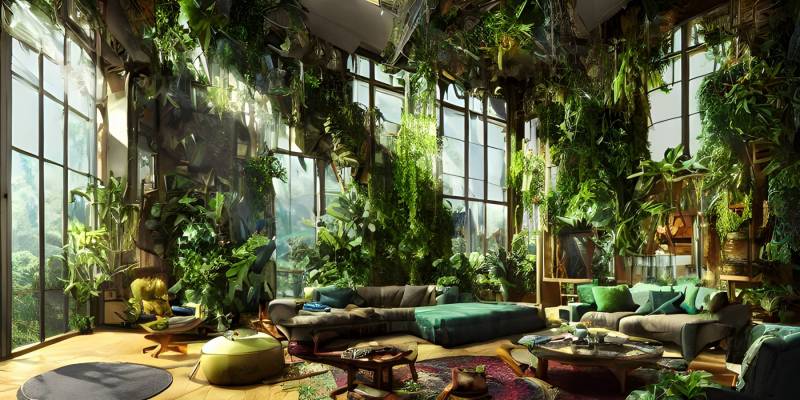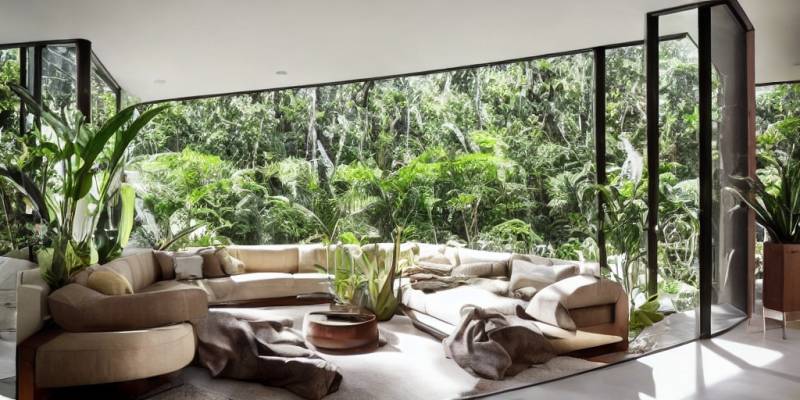Biophilic design is a concept that seeks to bring nature into the built environment. It is based on the idea that humans have an innate connection to nature and that this connection can be used to create healthier, more productive, and more sustainable spaces. The elements of biophilic design include natural materials, natural light, plants and vegetation, views of nature, natural sounds, and other features that evoke a sense of being in nature. By incorporating these elements into our home environment, we can create spaces that are not only aesthetically pleasing but also promote physical and mental well-being.
If you take a closer look at the structures, systems, and materials used in the construction of a house, you will find many parallels to those found in the human body. Biophilic design not only enhances our home décor, but also enables us to actively participate in the biophilic ecosystem and maintain an equilibrium of health. In the commercial side, our newly opened 1Hotel Hanalei Bay have embraced the idea of biophilic design in perfect alignment with the most sought-out trend. The private residential sector is catching up quickly, as homeowners realize the positive impact of this trend on their health.

Biophilic Element Air
One of the most important biophilic elements is often taken for granted: air. In sickness, our body is reminded of the most important, yet overlooked, aspect of health: our breath and the quality of the air. Understanding how air moves in your home is essential to your health. Since breathing is an involuntary process, most of us don’t think about the purity of the air around us. However, it is obvious that without oxygen, life would cease to exist. There are two aspects to consider: air quality and proper breathing. Proper breathing, when used correctly, can regulate systems in our body and improve wellbeing. Ancient technologies are still the most effective tools available today. They are free, but they require commitment.
Clean Air Solutions
Moving out of the city to a cleaner air environment is an effective solution, and I’m here to make the transition easier for you. Thanks to remote working, you can now relocate to our magnificent Kauai Island, and I will be happy to help you find the most suitable place for your needs. If that’s not an option for you, repositioning your existing home can also help bring nature back in and improve the air quality.
The Nature Way: Air moves from lower to higher levels in a home through convection. Hot air rises because it is less dense than cold air and thus creates a natural draft. This is why designing your home with windows in lower levels and adding roof windows can ease the air flow and bring clean air moving naturally with the heat. The lower-level windows create an area of low pressure, which draws in the surrounding air. This air is then pushed up by the warmer air, which naturally rises, and flies out the roof windows. This movement creates a continuous flow of air, which brings fresh air into the home and expels stale air. Additionally, by placing trees and shrubs near the windows, this can create a cooling effect and also provide additional ventilation.
The Technology Way: To optimize air quality, you can install central air filtering system that eliminates airborne pollen and dust particles. Ventilation, low VOC (Volatile Organic Compounds) products and hard flooring are also effective. We get so use to breathing the surrounding air and low oxygen levels that when we get into a clean air. environment, we wonder why we have so much more energy. According to EPA standards, air cleaners must be able to remove particles in the 0.1 range to be effective against viruses and other contaminants. Stand-alone air purifiers are a more accessible alternative. Equipped with built-in air quality sensors, they can detect changes in air quality and increase their operating speed to remove pathogens and particle matter.

Just Add Plants
Straight from the biophilic manual of standards comes the idea of integrating plants and flowers into your home. Not only do they add a touch of beauty and joy, but they also play an essential role in improving your health and well-being. In just 24 hours, indoor plants can reduce up to 87% of toxins in the air. This is especially beneficial as toxins often enter our homes through common materials such as wall paint, flooring adhesives, and coverings. Without plants, our air quality can suffer, leading to headaches, chronic fatigue, asthma, and other respiratory complications. Beyond the air purification benefits, plants also release oxygen through the process of photosynthesis. Oxygen is an essential element in our complicated human biology that helps us stay healthy and alert. What’s more, plants can even be used to separate and screen a space. In conclusion, adding plants to your home can help improve your health, productivity, creativity, and problem-solving skills. So don’t forget to include a few plants in your next home makeover!
Breathe With the Biophilic Ecosystem in Your Home
In the yogic world, this is known as Pranayama or Breath control. By mastering the air element and incorporating Pranayama into your daily life, you can truly create a biophilic lifestyle in your home. Pranayama can reduce stress and anxiety, improve concentration and focus, increase energy levels, strengthen the immune system, and promote better sleep. With regular practice, you can bring balance to your body, mind, and soul, allowing you to live a true biophilic lifestyle.
Decor for Wellness Practice
Designing or repositioning your home with biophilic elements can set the stage for healthy behaviors and replenish your energy — especially in our current world. Here are two options to consider, depending on your preferences:
Outdoor Ideas
A gazebo is an ideal setting for practicing Pranayama, particularly if you live in the tropics. To create an optimal environment, structures like octagons and hexagons work best, and the size can vary depending on the number of users. The gazebo must be screened and enclosed to keep out the elements, and cedar flooring is perfect, as its natural oils provide resistance to decay and insect damage. To make the most of this space, consider adding mirrors, a heater for hot yoga, a Buddhist or Hindu altar, meditation pillows, Tibetan singing bowls, gongs, bells, and a TV with Wi-Fi for streaming yoga and meditation classes. While this setup may cost up to 50K, there are other ways to practice yoga, meditation, pranayama, and chanting with an indoor area.
Indoor Ideas
Designate a room or area in your house that is suitable for yoga, meditation, pranayama, and chanting practice. Choose a spot with a pleasant view, facing east or north, and ensure it is free of clutter. Find a quiet and secluded area with good air circulation, and make sure it is off-limits to kids and pets. Label it ‘sacred’, and commit to a suitable morning practice time. Open the windows to let in fresh air and add inspirational items, such as a statue, incense, artwork, or whatever you need for your practice, such as a meditation cushion, yoga mat, blocks, or blankets. You can practice indoors or outdoors to best suit the capacity of your own space. Finally, let your home breathe along with you.
Keep an eye out for my upcoming publication, in which I’ll discuss the next vital element of biophilic design and lifestyle — water. If you have any questions or would like a copy of Hawai’i Life’s Luxury Market Report, please get in touch with me.

aura W hearne
March 23, 2023
such a wonderful concept!! I wonder if the idea can be adapted to meet the needs of those who do not have a lot of $$$$$……. to actually build a small house using many of the gorgeous features shown in the pictures……some of my family are moving from New Hampshire to the Big Island soon…. they might like to know more about “bringing the outside in”.